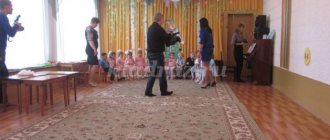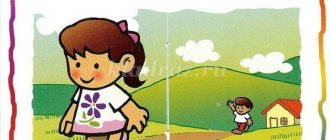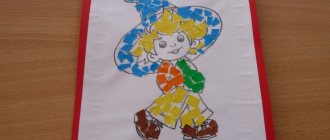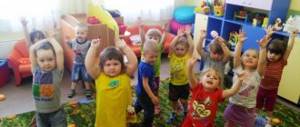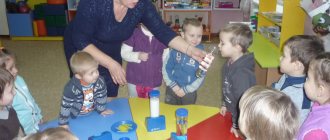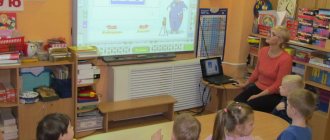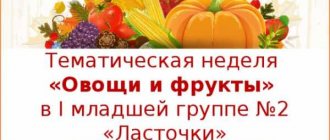The essence of the conversation technique
A conversation with pupils of a preschool educational institution (DOU) is a type of verbal interaction, which is an in-depth form of conversation with an entire group of children or individually, used to reveal in detail the essence of a specific phenomenon or object. Being a dialogical form of conversation, the conversation has a question-and-answer nature.
Conversation is an important speech technique when working with children.
Goals and objectives of the conversation in the second junior group
Any element of the educational process has a triune goal: cognitive, that is, teaching, developing and educational:
- broadens the horizons of children (for example, children 3–4 years old learn about the dangers that familiar toys, such as sand, pose);
- stimulates curiosity in learning about the world around them, themselves and other people (for example, kids learn the most interesting sights of their city);
- promotes speech development (for children of the second younger group this is a very important aspect of education, since it is at this age that children master the entire sound scale of the language, and also gain an understanding of the grammatical structure of speech);
- develops the ability to interact in a team - both with children and adults.
Considering that at 3–4 years old speech is actively mastered, the developmental tasks of conversation come to the fore:
- enrichment of active and passive vocabulary (in contrast to the first younger group, when mainly passive vocabulary was replenished);
- development of coherent monologue and dialogic speech (children not only answer the teacher’s questions, but also learn to maintain a conversation on a particular topic with each other, for example, find out the rules for handling a book - something that was not the case in the first junior group);
- developing the ability to systematize the thoughts expressed (for example, during a conversation on the topic “Guests have come to us,” children, naming greeting words, politeness formulas, draw up rules of etiquette when receiving guests);
- developing the ability to listen and hear the interlocutor (this goal runs through all the years of study at a preschool educational institution).
Conversation teaches kids to hear and listen to their interlocutor
Card index of safety conversations in the second junior group
Children 3-4 years old often become victims of accidents, so special attention should be paid to safety topics in preschool educational institutions.
For your information! It is important to convey information to parents of children about the need for prevention. At parent meetings, issue reminders and explain how best to convey information to children at this age.
Conversations are conducted with game elements, listening to theme songs, poems, viewing handouts (illustrations from books, cards, posters), as well as films and cartoons on relevant topics.
Minutes of safety in the junior group (file of topics):
- “Poisonous berries” (talk about poisonous berries, why they should not be eaten, especially pay attention to poisonous berries that are similar to edible ones).
- “Stop, dear!” (rules for crossing the roadway, rules of behavior near the road).
- “Red, yellow, green” (talk about traffic lights, what they are needed for, and what their colors mean, talk about the types of traffic lights).
- “Zebra is a striped friend. Safety at a pedestrian crossing."
- "Traveling in a car."
- “Bus, trolleybus, tram - open your doors!”
- “I’m lost” (rules of behavior in case of loss in a shopping center, at a train station or at the airport, on the street, in the forest).
- "Stranger."
- "What is height?"
- "Oh, fire!" (prohibition on playing with matches, lighters, gas burners; children's pranks with fire; basic rules for extinguishing a fire).
- "Dangerous electricity."
- "Who can help?"
Security Talk
- “I know how to make phone calls” (emergency services, relatives).
- “Be careful, ticks!”
- “How to behave with someone else’s dog” (discussion about precautions when communicating with dogs, explain how to properly establish contact if you want to communicate, how to give treats, behave when meeting an aggressive dog)?
- “Who is knocking at my house?”
- "Poisonous mushrooms."
- “Rabies, what should even a child know?”
- "Rules of behavior in a thunderstorm."
- “How to behave in strong winds?”
Step-by-step technique for drawing a portrait of a mother for children
Classification of conversations in the second junior group
Depending on the priority purpose of the conversation, as well as the place where it is held in the process of studying specific material, the Federal State Educational Standard (FSES) identifies several fundamental principles for classifying conversations, a number of which are used in the second junior group.
This is interesting. According to the content criterion, ethical and educational conversations are distinguished, which, according to the majority of methodologists, are not practiced in the second junior group. Ethical - only with older preschoolers, as they require a certain social experience of children, and cognitive ones are introduced into practice from the second half of the middle group due to the fact that they are based on analytically meaningful existing knowledge. At the same time, elements of both types of conversations are still necessarily (!) present in conversations with kids.
Table: classification of conversations according to various criteria
| Principle of classification | Conversation type | Goals | Examples, educational tasks |
| For educational purposes | Introductory |
| “Far and Near” Task: get to know the concepts of far and close in relation to yourself |
| Final | Systematize and clarify the knowledge acquired over a fairly long period of study time | “Clothes, shoes, hats” Objective: to consolidate knowledge of clothing items and the ability to describe their purpose | |
| By number of participants | Group |
| “Our favorite fairy tales” Tasks:
|
| Individual |
| “Let’s be polite to each other” Objective: to develop a friendly attitude towards other children, as well as develop the ability to find verbal resolution to conflicts | |
| By place in the educational process | Morning |
| “Magic words” Task: learn to be polite, say hello, say words of gratitude, say goodbye |
| Situational | Discuss the situation that has arisen (conflict, for example, when boys offend girls and vice versa) or what you have seen or heard during classes, walks or performing routine tasks (for example, what to do if the electricity unexpectedly turns off during a winter walk in the afternoon) | “Boys and Girls” Tasks:
| |
| By the nature of educational activities | Getting to know the world around you | Goals are determined by the particular objectives of specific educational activities in a given segment of the educational process. | “Butterflies”, “Mushrooms”, “Vegetables”, “Fruits” Tasks:
|
| By music | “We and Music” Tasks:
| ||
| In physical education | “Do exercises and you will be healthy” Objective: to get an idea of the importance of physical exercise for health. “Why does a person need sleep?” Task: to form an idea of the need for sleep for a person’s full functioning | ||
| Basics of life safety | “Dangers that exist in the house” Objective: to introduce possible sources of danger in the house (stove, water, electrical appliances). “Fire: good and evil” Task: get an idea of the rules for the safe use of household appliances | ||
| To develop cultural and hygienic skills | “It’s important to be neat” Task: to cultivate the habit of taking care of your appearance. “Rules of hand hygiene” Tasks:
| ||
| Depending on the organizer of the conversation | By narrow specialization | Conversation with a doctor on the topic “Why hardening is important”, with a policeman on the topic “What to do if you get lost” Task: find out a specific algorithm of actions in a given situation | |
Conversation when working with children 3–4 years old is often used to summarize the material covered.
CARD INDEX "Analysis of communication situations" card index (junior group) on the topic
Analysis of communication situations
Card 1
Topic: “We have new children.”
Goal: to help children get acquainted, make friends, encourage children to unite in play pairs and communities.
Card 2
Topic: “How together we worked and played today”
Goal: to develop children’s ability to see the results of joint work, to bring children to understand the phrase “friendly guys.”
Card 3
Topic: “We are friendly guys.”
Goal: to teach children to play together, not to quarrel, not to offend each other, to encourage children to share toys with each other, to develop the ability to negotiate, to cultivate tolerance, and communication skills.
Card 4
Topic: “Where do dolls and cars live?”
Goal: to help children remember the location of toys in a group, teach children to put them back in their place, and cultivate a caring attitude.
Card5
Topic: “Why do dolls cry?”
Goal: to teach children to put toys away in their designated place, to teach children to treat toys with care.
Card 6
Topic: “We are polite children.” Goal: to teach children to say hello when entering a group with adults and children, to respond to the greetings of other people; cultivate a culture of behavior in society.
Card 7
Topic: “What happened to Mishka?”
Goal: to introduce children to the situation (The dirty bear came home and sat down at the table to eat...); develop the ability to look at pictures and understand what is depicted in them; learn to compose sentences of 2-3 words; to form cultural and hygienic skills in children.
Card 8
Topic: “What happened to Mishka?”
Purpose: to introduce children to the situation (Teddy bear scattered toys in the room); develop the ability to look at pictures and understand what is depicted in them; learn to compose sentences of 2-3 words; to develop children’s work skills and to cultivate a caring attitude towards toys.
Card 9
Topic: “Guests came to us.”
Goal: to cultivate a culture of behavior in society, to teach children to say hello, to respond to other people’s greetings, to answer questions
Card 10
Topic: "Cars go to the garage."
Goals: to teach children to put toys in their place, to maintain the order of arrangement (large cars at the top, small ones at the bottom), and to cultivate a caring attitude towards them.
Card11
Topic: “What did we agree on?”
Goal: to teach children to put toys away and treat them with care; develop friendly relations between children, cultivate a desire to help each other, encourage the use of polite words in speech.
Card 12
Topic: “How toys took offense at children.”
Goal: to teach children to put toys away and treat them with care; develop friendly relations between children, cultivate a desire to help each other, and use polite words in speech.
Card13
Topic: “We have dolls visiting us.”
Goal: to form a culture of communication in children, to cultivate a careful, caring attitude towards toys, and the ability to conduct dialogue.
Card14
Topic: “We are not dogs, we are not biters.”
Goal: develop the need for communication and interaction, set an example of proper conflict resolution, and form friendly relationships.
Card file of conversations in the second junior group
Usually the teacher compiles a card index of conversations for the whole year, combining conversations of different types and topics. However, there is a practice of creating a block of conversations for specific types or topics. Here are a number of examples.
Table: card index of conversations in the second junior group for the year, author - Oksana Kulishina (fragment for November)
| Subject | Tasks |
| “What clothes do we need today?” |
|
| "Our friends are books" |
|
| "Cute toys" |
|
| "Boys and Girls" |
|
| "Traffic light" | Form children's ideas about situations dangerous to humans, familiarize them with road safety rules |
| Quote from: https://nsportal.ru/detskii-sad/vospitatelnaya-rabota/2017/11/08/temy-besed-vo-vtoroy-mladshey-gruppey | |
Table: card index of conversations on the topic of safety in the second junior group, author - Victoria Nechaeva (fragment)
| Subject | Tasks |
| "Safety in our group" |
|
| "Self-service" |
|
| “Dangerous situations: contacts with strangers on the street” |
|
| Quote from: https://www.maam.ru/detskijsad/kartoteka-besed-po-bezopasnosti-vo-921–921-mladshei-grupe.html | |
This is interesting. In the second junior group, conversations on the topic of safety are planned once every two weeks, that is, 17 times a year. Situational conversations are held outside the plan. And individual ones are compiled for a specific problem in the group, for example, if children or a child has problems with behavior at the table.
Table: card index of conversations on the environment in the second junior group, author - Larisa Ivakhova (fragment)
| Subject | Tasks |
| "Good Doctor Aibolit" |
|
| "Transport" |
|
| "How wild animals prepare for winter" |
|
| "Safe Road" |
|
| Quote from: https://kopilkaurokov.ru/doshkolnoeObrazovanie/prochee/kartotieka_biesied_po_oznakomlieniiu_s_okruzhaiushchim_mirom_vo_2_mladshiei_ghru | |
Topics of conversations with children in the second junior group
Tatiana Plotnikova
Topics of conversations with children in the second junior group
September
1. Conversation on the topic : “How to wash your hands correctly” Goal: to improve Ph.D., improve the simplest skills of behavior while washing.
2. Conversation on the topic “Sit correctly at the table” Goal: developing basic table behavior skills.
3. Conversation on the topic “Magic words” Goal: developing politeness in children (thank you for help, say goodbye and hello)
4. Conversation on the topic “I am good”
Goal: formation of elementary ideas about what is good and what is bad.
5. Conversation on the topic : “Golden Autumn” Goal: developing the ability to notice changes in nature. It gets colder and the leaves change color.
6. Conversation on the topic “Insects” Goal: expanding ideas about insects (3-4 species characteristic of the area)
7. Conversation on the topic “Tableware - tea and tableware” Goal: developing the ability to classify objects.
8. Conversation on the topic : “Parts of the day. What do we do in the morning, afternoon, evening, night” Goal: developing the ability to name the parts of the day.
9. Conversation on the topic “Our clothes” Goal: developing the ability to distinguish and name the details and parts of clothing (dresses have sleeves, coats have buttons)
10. Conversation on the topic “My Family” Goal: To consolidate knowledge about family members, the ability to name their names.
11. Conversation on the topic “Dangerous things” Purpose: getting to know the sources of danger at home.
12. Conversation on the topic “My days off”
.Tasks: Activate children’s vocabulary (weekends, at home, went, played, fun, friendly, interesting, worked, taught to answer the teacher’s questions.
13. Conversation on the topic “What I saw on the way to kindergarten”
.Tasks: Continue work to activate and expand children’s vocabulary, clarify the names of familiar objects and phenomena.
14. Conversation on the topic “Clothing”
.Objectives: To tell children about the seasons, to help them understand the relationship between weather changes and people’s clothing.
15. Conversation on the topic “Hats”
Objectives: Enrich children's understanding of their immediate surroundings, activate their vocabulary, teach them to name items of clothing
(hats)
.
16. Conversation on the topic “Our clothes”
.Tasks:Teach children to understand generalizing words: clothes, hats. Clarify the names and purposes of items, features of their use.
17. Conversation on the topic “Clothing, hats”
Objectives: To consolidate
children’s understanding of generalizing words , to teach them to distinguish and name the qualitative characteristics of hats and clothing (color, shape, size)
.
18. Conversation “How the kids met the wolf”
.Objectives: To instill in children a sense of caution, to introduce them to the rules of behavior when meeting strangers.
19. Conversation “Appearance and intentions”
, reading an excerpt from the fairy tale
“The Three Little Pigs.”
Tasks: Continue to introduce children to the rules of conduct when meeting strangers. Cultivate a sense of caution when communicating with strangers.
20. Conversation “Table behavior”
.Tasks: To develop cultural and hygienic skills in children, to introduce them to table manners, to teach them to eat carefully, and to use a napkin.
21. Conversation “Appearance and intentions”
, watching an excerpt from a cartoon based on A. Pushkin’s fairy tale
“The Tale of the Dead Princess and the Seven Knights.”
Tasks: Continue to acquaint children with the rules of communication with strangers, instill caution and prudence
22. Conversation “Table behavior”
.Tasks: To develop cultural and hygienic skills in children, continue to familiarize them with table manners, and teach them to apply them in practice. Learn to use a napkin and hold a spoon correctly.
23. Conversation on the topic “Puppet theater”
Objectives: To introduce children to the activities of puppet theater and the features of this type of art. Talk about the rules of behavior in the theater.
24. Conversation “Table behavior”
.Objectives: To develop self-service skills and cultural and hygienic skills, teach children to take their places at the table in an organized manner, eat independently and carefully, and hold a spoon correctly.
25. Conversation on the topic “Clean hands”
.Objectives: Tell children why it is important to wash their hands thoroughly after a walk, visiting the toilet, and before eating. Offer to show how to wash your hands correctly.
26. Conversation “Table behavior”
.Tasks: To develop cultural and hygienic skills in children, continue to familiarize them with the rules of behavior at the table, teach them to eat carefully, and use a napkin correctly.
27. Conversation “Let’s be polite”
.Objectives: Teach children to use polite words and expressions, discuss in what situations they should be used, what their meaning is.
28. Conversation on the topic “Me and my health”
.Objectives: Tell children that health is one of the main values of life. Form basic ideas about how to take care of your health.
29. Conversation on the topic “In the world of kind words”
.Objectives: Teach children to use polite words and expressions in various situations, show with examples the meaning of polite words. Enrich your vocabulary.
30. Conversation on the topic “Don’t jump from high objects”
Objectives: To form basic ideas about how to take care of health.
31. Conversation on the topic “Never spoil books”
Objectives: Learn to take care of books. Instill accuracy and thrift.
Long-term planning of conversations in the second junior group
Conversations in the second junior group are held once a week. The only exception is situational and individual conversation, which has a precedent, that is, situational character.
Table: long-term plan for conversations in the second junior group for October and November, author - Anzhelika Shevchenko
| October | ||||
| Day of the week | 1 Week | 2 week | 3 week | 4 week |
| Monday | “I behave well at the table” Goal: development of basic behavior skills (use a tablespoon, a napkin correctly, do not crumble, do not talk) | “Cleanliness and neatness” Goal: developing the habit of taking care of your appearance (using a comb, washing your face) | “Take care of toys” Goal: encouraging children’s desire to live together and use toys together | “How to behave in a group” Objectives:
|
| Tuesday | “Autumn has come and brought us a harvest” Goal: expanding the idea that vegetables and fruits are harvested in the fall | “Wild Animals” Goal: expanding ideas about wild animals of 3–4 species characteristic of the area | “Russian Matryoshka” Goal: development of the desire to listen to the teacher’s stories about things understandable to children | “Tell about your pet” Goal: developing the need to share your impressions with the teacher and with peers |
| Wednesday | “What clothes are worn in autumn” Goal: developing the ability to establish the simplest connections between objects and phenomena, make the simplest generalizations | “Profession of a doctor” Goal: introducing children to understandable professions | “What kinds of toys are there?” Purpose: to improve the ability to coordinate adjectives with nouns in gender, number, case | “Seasons” Goal: to engage children in conversation while looking at paintings |
| Thursday | “Grandparents” Goal: to consolidate the ability to name the names of family members | “Who lives in the apartment with you” Purpose: to consolidate children’s knowledge about family members | “Folk toys” Goal: acquaintance with native culture, toys of folk craftsmen | “Who works in kindergarten” Purpose: recalling the names and patronymics of kindergarten workers |
| Friday | “Gifts of Autumn” Goal: developing ideas about healthy food | “What you need to do to avoid getting sick” Goal: developing an idea of the value of health, the desire to lead a healthy lifestyle | “How to cross the road correctly” Goal: developing an understanding of safe behavior on the road | “How to go down the stairs correctly” Goal: developing skills for safe behavior indoors |
| November | ||||
| Monday | “You have to be neat” Goal: developing the habit of taking care of your appearance | “How to wash your hands correctly” Purpose: to reinforce the correct way of washing hands and using soap | “Let's say magic words to a friend” Goal: developing a friendly attitude towards each other | “If a friend cries, have pity on him” Goal: encouraging attempts to pity a peer, hug, help |
| Tuesday | “Autumn has come to visit us” Goal: developing the ability to notice changes in nature | “Changes in nature” Goal: developing ideas about the simplest relationships in living and inanimate nature | “Domestic and wild animals” Goal: developing the ability to conduct a dialogue with a teacher, listen, understand the question asked, and answer it clearly | “Winter is coming” Goal: expand your understanding of the seasons, develop speech |
| Wednesday | “Far - close” Goal: development of the ability to determine the location of objects in relation to oneself, that is, far - close | “Our street” Purpose: getting to know your immediate environment (house, street, store, clinic) | “Favorite Tales” Goal: development of initiative speech when interacting with adults and children | “Healthy Products” Goal: developing knowledge about healthy foods |
| Thursday | “When I was little” Purpose: telling children information about the past (I couldn’t walk, talk, ate from a bottle) and the changes that happened to them | “Boys and girls” Goal: formation of primary gender ideas (boys are strong, girls are gentle) | “Our group” Goal: to encourage children to organize the group as best they can (arrange books and toys beautifully) | “How I spent the weekend” Purpose: to encourage children to talk about where they went for a walk on the weekend |
| Friday | “Do exercises - you will be healthy” Goal: to form the idea that morning exercises cause a good mood | “Why you need to sleep” Purpose: to form the idea that strength is restored with the help of sleep | “Dangerous objects at home” Purpose: familiarization with sources of danger at home | “Good and Evil Fire” Purpose: to develop knowledge about safety rules when using household appliances |
| Quote via: https://nsportal.ru/detskii-sad/vospitatelnaya-rabota/2017/01/16/planirovanie-besed-v-mladshey-gruppe | ||||
Topics of conversations with children in the first junior group
Elena Borisova
Topics of conversations with children in the first junior group
1. Conversation on the topic : “How to wash your hands correctly” Goal: to improve Ph.D., improve the simplest skills of behavior while washing.
2. Conversation on the topic “Sit correctly at the table” Goal: developing basic table behavior skills.
3. Conversation on the topic “Magic words” Goal: developing politeness in children (thank you for help, say goodbye and hello)
4. Conversation on the topic “I am good”
Goal: formation of elementary ideas about what is good and what is bad.
5. Conversation on the topic : “Golden Autumn” Goal: developing the ability to notice changes in nature. It gets colder and the leaves change color.
6. Conversation on the topic “Insects” Goal: expanding ideas about insects (3-4 species characteristic of the area)
7. Conversation on the topic “Tableware - tea and tableware” Goal: developing the ability to classify objects.
8. Conversation on the topic : “Parts of the day. What do we do in the morning, afternoon, evening, night” Goal: developing the ability to name the parts of the day.
9. Conversation on the topic “Our clothes” Goal: developing the ability to distinguish and name the details and parts of clothing (dresses have sleeves, coats have buttons)
10. Conversation on the topic “My family” Goal: To consolidate knowledge about family members, the ability to name their names.
11. Conversation on the topic “Dangerous things” Purpose: getting to know the sources of danger at home.
12. Conversation on the topic “My days off”
.Tasks: Activate children’s vocabulary (weekends, at home, went, played, fun, friendly, interesting, worked, taught to answer the teacher’s questions.
13. Conversation on the topic “What I saw on the way to kindergarten”
.Tasks: Continue work to activate and expand children’s vocabulary, clarify the names of familiar objects and phenomena.
14. Conversation on the topic “Clothing”
.Objectives: To tell children about the seasons, to help them understand the relationship between weather changes and people’s clothing.
15. Conversation on the topic “Hats”
Objectives: Enrich children's understanding of their immediate surroundings, activate their vocabulary, teach them to name items of clothing
(hats)
.
16. Conversation on the topic “Our clothes”
.Tasks:Teach children to understand generalizing words: clothes, hats. Clarify the names and purposes of items, features of their use.
17. Conversation on the topic “Clothing, hats”
Objectives: To consolidate
children’s understanding of generalizing words , to teach them to distinguish and name the qualitative characteristics of hats and clothing (color, shape, size)
.
18. Conversation “How the kids met the wolf”
.Objectives: To instill in children a sense of caution, to introduce them to the rules of behavior when meeting strangers.
19. Conversation “Appearance and intentions”
, reading an excerpt from the fairy tale
“The Three Little Pigs.”
Tasks: Continue to introduce children to the rules of conduct when meeting strangers. Cultivate a sense of caution when communicating with strangers.
20. Conversation “Table behavior”
.Tasks: To develop cultural and hygienic skills in children, to introduce them to table manners, to teach them to eat carefully, and to use a napkin.
21. Conversation “Appearance and intentions”
, watching an excerpt from a cartoon based on A. Pushkin’s fairy tale
“The Tale of the Dead Princess and the Seven Knights.”
Tasks: Continue to acquaint children with the rules of communication with strangers, instill caution and prudence
22. Conversation “Table behavior”
.Tasks: To develop cultural and hygienic skills in children, continue to familiarize them with table manners, and teach them to apply them in practice. Learn to use a napkin and hold a spoon correctly.
23. Conversation on the topic “Puppet theater”
Objectives: To introduce children to the activities of puppet theater and the features of this type of art. Talk about the rules of behavior in the theater.
24. Conversation “Table behavior”
.Objectives: To develop self-service skills and cultural and hygienic skills, teach children to take their places at the table in an organized manner, eat independently and carefully, and hold a spoon correctly.
25. Conversation on the topic “Clean hands”
.Objectives: Tell children why it is important to wash their hands thoroughly after a walk, visiting the toilet, and before eating. Offer to show how to wash your hands correctly.
26. Conversation “Table behavior”
.Tasks: To develop cultural and hygienic skills in children, continue to familiarize them with the rules of behavior at the table, teach them to eat carefully, and use a napkin correctly.
27. Conversation “Let’s be polite”
.Objectives: Teach children to use polite words and expressions, discuss in what situations they should be used, what their meaning is.
28. Conversation on the topic “Me and my health”
.Objectives: Tell children that health is one of the main values of life. Form basic ideas about how to take care of your health.
29. Conversation on the topic “In the world of kind words”
.Objectives: Teach children to use polite words and expressions in various situations, show with examples the meaning of polite words. Enrich your vocabulary.
30. Conversation on the topic “Don’t jump from high objects”
Objectives: To form basic ideas about how to take care of health.
31. Conversation on the topic “Never spoil books”
Objectives: To teach how to treat books with care. Instill accuracy and thrift.
32. Conversation with children on the topic “Vegetables”
.Goal: to expand the understanding of the benefits of vegetables, to enrich the vocabulary with verbs and adjectives.
Techniques used in conversations in the second junior group
As already noted, conversation is a type of verbal group of means of interaction with children. But when organizing work within the framework of this technique, other methods of interaction are no less important.
To realize the educational goals of the conversation, the teacher combines all groups of methodological techniques, including practical ones
Table: techniques for conducting a conversation in the second junior group, author - Natalya Vasylishin
| Reception group | View | At what stage of the conversation is it used? | Example |
| Verbal | Explanation | On the main | I usually use this technique to introduce new information during a conversation. For example, during a conversation about family, I explain the concept of great-aunt and great-uncle as follows: “You have brothers and sisters, just like your grandparents have brothers and sisters. Although they are not close to you, they are relatives, that’s why they are called cousins.” |
| Rhymes (riddles, poems) | At the introductory or final stage. Learning poems, if this type of work is expected, or compiling a selection of riddles is carried out in preparatory | Before starting a conversation about friendship, I read a poem to the kids:
| |
| Fairy tales | On the main | When discussing the importance of hand washing, I tell my students a story about a Microbe. “Once upon a time there was a Microbe, small and harmful. He loved to cause stomach pains in children. As soon as one of the kids takes a pear or an apple with dirty hands, a Microbe is right there. But the children got tired of getting sick, and then the Fairy of Purity advised the children not to forget to wash their hands before eating. Microbe got bored and left, and the kids stopped getting sick.” After discussing the questions (“Why were the children sick?”, “What did the Fairy of Purity advise the children?”, etc.), we come to the conclusion about the importance of maintaining personal hygiene | |
| Pure talk | At the final | You can end the conversation about personal hygiene with a clean statement:
| |
| Visual | Pictures, posters, layouts | For everyone | During the conversation about traffic rules, I invite my children to look at the layout of the roadway, repeat the traffic lights, and the actions of pedestrians |
| Demonstration | On the main | This technique implies that the teacher shows some actions to the children, for example, the order of performing movements in an outdoor game or the algorithm of brush strokes when making a drawing (Christmas tree, grass, etc.) | |
| Showing presentations and videos | On the main | To deepen the consideration of the issue of hygiene in a conversation, I use the screening of a thematic video about Smeshariki | |
| Observations | During the preparatory | Before talking about life in the city, I suggest that children, while walking and on the way home, observe the flow of cars on the roads, note the contamination of the snow lying along the roads, and also pay attention to emissions from boiler pipes | |
| Gaming | Didactic | At the final | You can finish the conversation about vegetables with the game “Match the tops to the roots”: children find parts of soft vegetable toys by connecting them with Velcro |
| Theatrical | I practice completing a conversation about transport in the city in the form of a role-playing game “On the Bus”, in which the kids repeat the rules of behavior in public transport | ||
| Movable | I end the conversation about human labor with my students in the fall with an active imitation game “Two sisters, two hands”:
| ||
| Practical | Drawings, applications, crafts | We end our conversation about the trees of our native land with our students with a drawing of a rowan tree, which is done with our fingers |
Video: demonstration as a technique in conversation - Smeshariki about personal hygiene
Methodology for conducting a generalization conversation in the second junior group
The structure of preparing and conducting a conversation with children does not depend on its type and consists of four stages. In this case, the timing is determined by the tasks and content, therefore it ranges from 5 minutes (for example, if the conversation is individual and situational) to 15 minutes when it comes to a general conversation, morning conversation or any other.
Table: stages of organizing a conversation in the second junior group
| Stage | The essence | Example |
| Preparation |
| Before the conversation on the topic “Plants and Shrubs”:
|
| Introduction | Evoke a vivid image from the memory of children with the help of a story, clarity in the form of pictures, toys, riddles, poems on the topic | A conversation on the topic “Healthy lifestyle in a big city” can be started by looking at pictures of pedestrians on the street with different facial expressions. Focusing on a sad person walking along a dusty sidewalk, we come to the conclusion that emotional health depends on physical health. |
| Main stage |
| In the conversation “We are friends with sports,” the main stage begins with questions:
Then the teacher reads T. Volgina’s poem “Two Friends” to the children and asks them to answer the questions:
The teacher brings to the conclusion about the need to play sports |
| The final stage | The teacher invites the children to sing a song on the topic, remember a poem or play a game | A conversation about transport can be completed with an educational printed board game “Who drives what?”: the teacher shows pictures depicting people of different professions, children determine what kind of transport they drive, focusing on the cards on their tables |
Conducting a conversation consists of three stages of work plus a preparatory stage, including the choice of clarity and content of games
Table: example of a summary of a conversation on the topic “Human Body” in the second junior group, author - Svetlana Nesterova (fragments)
| Stage | Content |
| Preparatory | Prepare pictures depicting dolls of different appearances, a toy doll Masha |
| Introductory | The doll Masha came to visit and brought pictures with images of her friends. Pay attention that all the dolls are different (height, hair and eye color), offer to find the differences, bring to the conclusion: they all have the same body parts (offer to show them on yourself) |
| Basic | Answer the questions:
|
| Look at photographs of children of different ages, pay attention to changes in their growth. Encourage you to come to the conclusion: to grow big, strong and healthy, you need to eat well, exercise and take care of your health | |
| Final | Children play the active game “Show it correctly”: the teacher names one part of the body and shows another. Children must repeat the name, but show it correctly |
| Quote from: https://nsportal.ru/detskiy-sad/razvitie-rechi/2014/03/18/metodika-provedeniya-besedy-s-detmi-v-doshkolnykh | |

